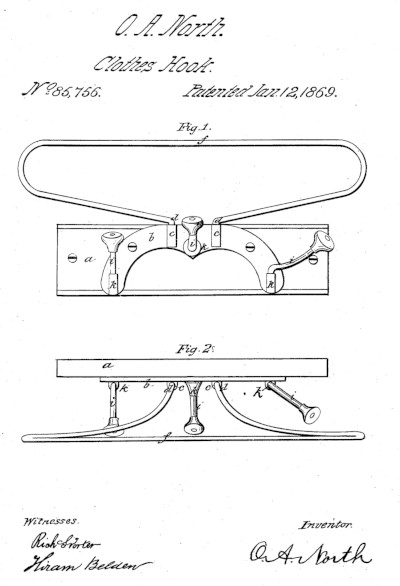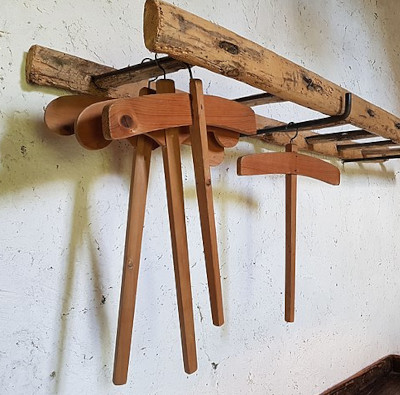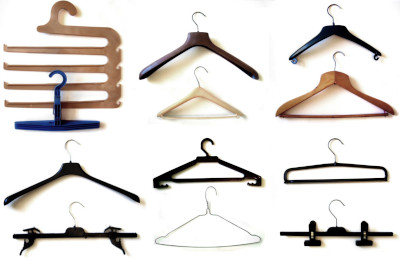Hang it up!
Did you know that every time you put a garment on the conveyor belt or rack, you’re handling history? Just for fun, let’s look at the checkered past of the humble clothes hanger.

Though Thomas Jefferson is said to have made some kind of gizmo for hanging up his clothes (as well as a desk chair that swiveled and a lot of other things) the most common attribution for the invention of the hanger we know and love today is O.A. North of New Britain, Connecticut, in 1868.
North made something out of wire that mimicked the shape of human shoulders and had a hook at the top so it could be hung up. Amazing to think that it was part of an overall societal change.
The need to hang garments came about as part of the rise of a middle class. Suddenly, there were fewer labourers and more men who reported to work in offices where they were expected to wear clean, unwrinkled suits each day. The problem was, they may have moved up in the world, but they didn’t have staff to look after those garments like the upper class did.
Enter the clothes hanger. And the closet. Today we can’t imagine a home without closets for clothes. It took a hundred years for hangers to come into in common daily use, but once they did, a closet was a good place to hang the clothes to keep them all together. So, hangers drove interior design.

Hangers seem like a no-brainer, now that you’ve seen and used them, yet in their day they were revolutionary. And they continue to evolve. Hangers have been patented over 200 times in the United States alone.
O.A. North may have been first, but he was at the head of a pack of creative engineers determined to make life a little easier. The story goes that in 1903, Albert J. Parkhouse arrived at work a little late and found every coat hook in use. Frustrated, he grabbed a piece of wire and twisted it into the shape we all recognize as a hanger today, and hung up his coat.
Other innovations followed, like wooden reinforcements (because the wire is flexible, and garments used to be a lot heavier than they are today) and various kinds of guards on the frame of the hanger to limit wrinkling.
Meyer May, a men’s clothier in Grand Rapids, Michigan, was the first credited with displaying garments for sale on his wishbone-inspired hangers in 1906. What would the modern clothes store be without that simple innovation?
It wasn’t until 1967 that J.H. Batts patented an inexpensive molded plastic hanger, which was easier and cheaper to manufacture. The Sixties were a time of all-things-plastic, so it’s only natural the ubiquitous hanger would get a quick make-over then.
Some of the other tweaks to the original design include:

- hangers that hold multiple items
- hangers for specific types of clothing or textiles
- luxury/custom-made hangers
- scented hangers
- padded hangers
- hangers with clips
- larger hangers for blankets, drapes, etc.
- small hangers for children’s clothing
- hangers with flocking or other non-skid materials to keep clothes from falling off
- colour-coordinated hangers
- hangers made from recycled materials
- foldable clothes hangers for travel or quick use in odd places
Of course, anything so popular as hangers will find its way into use in other “off-label” ways. You’ve no doubt used them for many things besides garment care, yourself. Consider some of the less usual usages:

- in craft projects
- handy bailing wire for closing gates or other home projects
- makeshift welding rod (used for over 100 years)
- dowsing rods
- (after sanding) to hot-wire cars
- gain entry to older autos with pull-up lock systems
- replacement for car antenna
- roasting marshmallows or hot dogs at camp- outs
- In 1995, Professor Angus Wallace used an unfolded coat hanger, sterilized with brandy, to perform emergency surgery on the collapsed lung of another passenger on an airliner at 35,000 feet. (Yeah, it’s hard to block that mental image….)
So, the next time you reach for a hanger and slide a freshly cleaned and pressed garment or textile on it, pause for just a second to tip your hat to the innovators and inventors who made it possible for you to do that. They had a hang-up about a daily problem, and you are the beneficiary of their solution.







